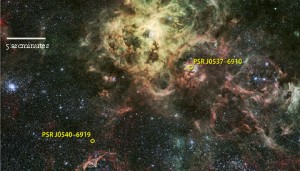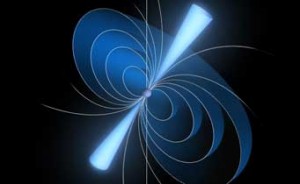The Fermi Gamma-ray Space Telescope has discovered that almost all of the highest energy photons in the Large Magellanic Cloud come from two pulsars.

Labels: NASA Goddard; Nebula: ESO / R. Fosbury (ST-ECF)
Pulsars are the lighthouses of astronomy. These dense, dead stars sweep a beam of radiation across our view as they whip around at breakneck speeds. Astronomers usually detect pulsars at radio wavelengths, but about 5% of them — generally the youngest ones — also emit gamma rays, photons with millions to hundreds of billions of times the energy of visible-light photons.
Since its launch in 2008, NASA’s Fermi Gamma-ray Space Telescope has detected more than 160 pulsars with gamma-ray beats, all within our Milky Way Galaxy. In the November 13th Science and at the annual International Fermi Symposium, Pierrick Martin (Institute for Research in Astrophysics and Planetology, France), Frank Marshall (NASA Goddard), and colleagues report that they’ve now detected gamma rays from two pulsars outside of our galaxy. The pulsars live in the prolific star-forming Tarantula Nebula in the Large Magellanic Cloud, a dwarf galaxy currently making a pass at (and being chewed up by) our galaxy.
But the discovery actually makes the region’s gamma rays more mysterious, not less.
Fermi had previously detected gamma rays from the Tarantula Nebula, but not with enough resolution to say exactly where the emission was coming from. Gamma rays are fairly rare as photons go, and because the LMC is more than 160,000 light-years away, the team had to wait more than six years before amassing enough gamma-ray detections to be able to pinpoint the sources.
For this same reason, the astrophysicists couldn’t just search the gamma rays for a pulse pattern. Instead, they used more than a decade of observations from the Rossi X-ray Timing Explorer satellite to determine the pulsars’ periods, then looked for those patterns in gamma rays.
One of the pulsars, J0540-6919, has gamma-ray pulses that closely match its radio and X-ray pulses. It’s the most luminous gamma-ray pulsar ever observed — more than 20 times brighter than the pulsar powering the Crab Nebula, which was the champion. As with other pulsars, this emission is powered by energy sapped from its decaying rotation.
The second pulsar, J0537-6910, actually doesn’t show any pulse pattern in its gamma rays. That’s curious.
Gamma-ray Mysteries

ESA / ATG medialab
These discoveries have two implications. First, J0540, J0537, and the Crab pulsar are all very young (about a thousand years old) and rapidly rotating — and those spins are quickly slowing down, powering the pulsars’ emission. Yet the stars don’t look anything alike in gamma rays. So what’s up?
It might have something to do with geometry. Pulsars produce energetic photons thanks to their strong magnetic fields. We see pulsars pulse because the axis of the neutron star’s global magnetic field is offset from its rotational axis, so the beam whirls in and out of our vision as the dead star turns. The degree of this misalignment may affect both the emission’s creation and what we see.
Second, these two pulsars together account for about 85% of the gamma rays coming from the Tarantula Nebula. Before this discovery, astronomers thought such high-energy photons could be coming from cosmic rays, super-speedy particles flying through space. Previous observations have strongly suggested that cosmic rays with the needed high energies might be produced in star-forming regions like the Tarantula Nebula, thanks to supernovae or the hot, turbulent environment created by young massive stars. Yet even though the Tarantula is the most active star-forming region in our galactic neighborhood — beating anything in the Milky Way — its gamma rays come almost entirely from these two pulsars. The team doesn’t know yet what, if anything, that means for our understanding of cosmic rays, Martin says.
Below, you can watch a NASA video that nicely summarizes the Fermi team’s findings.
Reference: The Fermi Collaboration. "An Extremely Bright Gamma-ray Pulsar in the Large Magellanic Cloud." Science. November 13, 2015.
You can only observe the Large and Small Magellanic Clouds from the Southern Hemisphere. If you live there or are going there soon, pick up our Southern Hemisphere star wheel to help you navigate the skies!
 0
0









Comments
You must be logged in to post a comment.